Contents
| |||||
| Decades: | |||||
|---|---|---|---|---|---|
| See also: | Other events of 1935 History of Bolivia • Years | ||||
This article needs additional citations for verification .(February 2024) |
Events in the year 1935 in Bolivia .
| |||||
| Decades: | |||||
|---|---|---|---|---|---|
| See also: | Other events of 1935 History of Bolivia • Years | ||||
This article needs additional citations for verification .(February 2024) |
Events in the year 1935 in Bolivia .
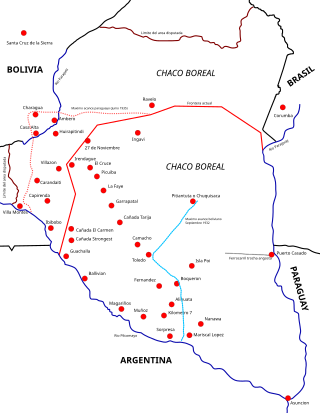
The Chaco War was fought from 1932 to 1935 between Bolivia and Paraguay, over the control of the northern part of the Gran Chaco region of South America, which was thought to be rich in oil. The war is also referred to as La Guerra de la Sed in literary circles since it was fought in the semi-arid Chaco. The bloodiest interstate military conflict fought in South America in the 20th century, it was fought between two of its poorest countries, both of which had lost territory to neighbours in 19th-century wars.

The Battle of Sacile on 16 April 1809 and its companion Clash at Pordenone on 15 April saw an Austrian army commanded by Archduke John of Austria defeat a Franco-Italian army led by Eugène de Beauharnais and force it to retreat. Sacile proved to be the most notable victory of John's career. The action took place east of the Livenza River near Sacile in modern-day Italy during the War of the Fifth Coalition, part of the Napoleonic Wars.

The Pancho Villa Expedition—now known officially in the United States as the Mexican Expedition, but originally referred to as the "Punitive Expedition, U.S. Army"—was a military operation conducted by the United States Army against the paramilitary forces of Mexican revolutionary Francisco "Pancho" Villa from March 14, 1916, to February 7, 1917, during the Mexican Revolution of 1910–1920.

The Battle of Komarów, or the Zamość Ring, was one of the most important battles of the Polish-Soviet War. It took place between 20 August and 2 September 1920, near the village of Komarowo near Zamość. It was the last large battle in Europe in which cavalry was used as such and not as mounted infantry.

The Battle of Ayacucho was a decisive military encounter during the Peruvian War of Independence. This battle secured the independence of Peru and ensured independence for the rest of South America. In Peru it is considered the end of the Spanish American wars of independence in this country, although the campaign of Antonio José de Sucre continued through 1825 in Upper Peru and the siege of the fortresses Chiloé and Callao eventually ended in 1826.

Rafael de la Cruz Franco Ojeda was a Paraguayan military officer, politician and statesman who served as President of Paraguay after the February Revolution, from February 20, 1936, to August 13, 1937. He was the historical leader and founder of the National Revolutionary Party.

The Battle of Yungay was the final battle of the War of the Confederation, fought on January 20, 1839, near Yungay, Peru. The United Restoration Army, led by Chilean General Manuel Bulnes, consisting mainly of Chileans and 600 North Peruvian dissidents, attacked the Peru-Bolivian Confederation forces led by Andrés de Santa Cruz in northern Peru, 200 kilometers (120 mi) north of Lima.

In the Paraguayan War, the Battle of Yatay was fought on August 17, 1865, between the troops of the Triple Alliance and the soldiers of Paraguay near Paso de los Libres, Corrientes, Argentina.
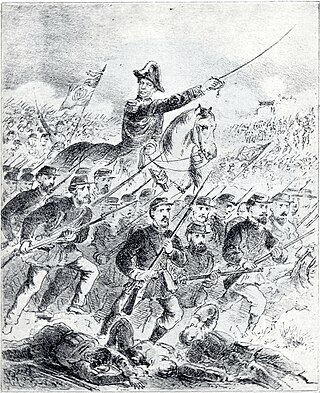
On the morning of 6 December 1868, marshal of the Imperial Brazilian Army, Luís Alves de Lima e Silva, Marquis of Caxias, moved with 16,999 infantrymen, 926 cavalrymen and 742 artillerymen, to take Villeta, a Paraguayan city, as a plan to make further attacks on the Paraguayan Army rear. Nevertheless, Paraguayan president and commander-in-chief of the army Francisco Solano López was aware of the landing the Allies had made in the rear of his army.

The Battle of San Francisco, also known as the Battle of Dolores, was a major battle in the Tarapacá Campaign of the War of the Pacific, fought on November 19, 1879, in the Peruvian department of Tarapacá. A Chilean army under Colonel Emilio Sotomayor had moved via Dolores rail road deep into the desert and was encamped at San Francisco Saltpeter Office, about 30 kilometers south east of the port of Pisagua. Allied forces under General Juan Buendía launched an attack on Sotomayor's army. At the beginning, Bolivian General Carlos de Villegas pressed the attack over a poorly defended battery right in the Chilean centre and almost succeeded. Only the arrival of infantry support allowed Colonel José Domingo Amunátegui to hold the position.

The Battle of Estero Bellaco was one of the bloodiest battles of the Paraguayan War. The battle was fought on 2 May 1866 with the Paraguayan Army suffering 2,000 casualties among the dead and wounded. Likewise, 300 of their men were taken prisoner by the troops belonging to the Triple Alliance: Argentina, Brazil and Uruguay. The allies lost nearly 2,000 men, mostly wounded, and the Uruguayan troops of General Venancio Flores - commanded by León de Pallejas - were severely decimated, accounting for the vast majority of allied deaths.

The Battle of Tacna, also known as the Battle of the Peak of the Alliance, effectively destroyed the Peru-Bolivian alliance against Chile, forged by a secret treaty signed in 1873. On 26 May 1880, the Chilean Northern Operations Army led by General Manuel Baquedano González, conclusively defeated the combined armies of Peru and Bolivia commanded by Bolivian President, General Narciso Campero. The battle took place at the Inti Urqu (Intiorko) hill plateau, a few miles north of the Peruvian city of Tacna. As a result, Bolivia was knocked out of the war, leaving Peru to fight the rest of the war alone. Also, this victory consolidated the Chilean domain over the Tarapacá Department. The territory was definitively annexed to Chile after the signing of the Tratado de Ancón, in 1884, which ended the war. Tacna itself remained under Chilean control until 1929.
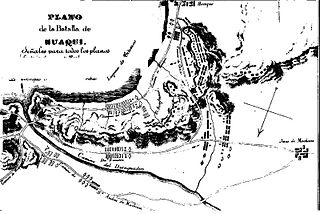
The Battle of Huaqui or Battle of Guaqui-modern spelling-, was a battle on June 20, 1811, between the Primera Junta's revolutionary troops and the royalist troops of the Viceroyalty of Peru on the border between Upper Peru,, resulting in a comprehensive defeat of the revolutionary armies.

The Army of the North, contemporaneously called Army of Peru, was one of the armies deployed by the United Provinces of the Río de la Plata in the Spanish American wars of independence. Its objective was freeing the Argentine Northwest and the Upper Peru from the royalist troops of the Spanish Empire. It was headed by Hipólito Vieytes (1810), Juan José Castelli (1810–1811), Juan Martín de Pueyrredón (1811–1812), Manuel Belgrano (1812–1814), José de San Martín (1814), José Rondeau (1814–1816), Manuel Belgrano (1816–1819) and Francisco Fernández de la Cruz (1819–1820).
The Battle of Tacuarí was a battle in Southern Paraguay between revolutionary forces under the command of General Manuel Belgrano, member of the Primera Junta government of Argentina, and Paraguayan troops under colonel Manuel Atanasio Cabañas, at the time at the service of the royalists.

The Battle of Campo Grande was a major engagement during the Chaco War, in the southern region of the Chaco Boreal. During this battle, the Paraguayan Army successfully encircled two Bolivian regiments defending two of the three flanks of Fort Alihuatá, forcing them to surrender.
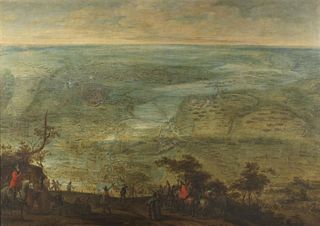
The siege of Saint-Omer was a siege in the Thirty Years' War in which a French army under Gaspard III de Coligny, Maréchal de Châtillon, laid siege to the Flemish city of Saint-Omer, defended by a small garrison in command of Lancelot II Schetz, count of Grobbendonck. Despite several initial successes in the capture of the minor forts around Saint-Omer, on the night of 8/9 June a Spanish relief army under Thomas Francis, Prince of Carignano, surprised Châtillon's troops and established a small fort in the middle of the French lines. An entire army corps under Maréchal de La Force was ordered to move towards Saint-Omer to support Châtillon siege, but on 12 July a further Imperial-Spanish force commanded by Ottavio Piccolomini entered Saint-Omer, resolving the French marshals to withdraw.
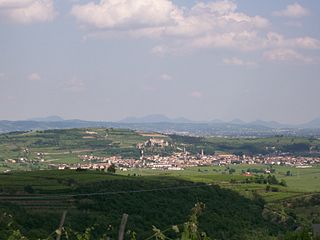
In the Battle of Caldiero or Battle of Soave or Battle of Castelcerino from 27 to 30 April 1809, an Austrian army led by Archduke John of Austria defended against a Franco-Italian army headed by Eugène de Beauharnais, the Viceroy of the Kingdom of Italy. The outnumbered Austrians successfully fended off the attacks of their enemies in actions at San Bonifacio, Soave, and Castelcerino before retreating to the east. The clash occurred during the War of the Fifth Coalition, part of the Napoleonic Wars.

The Tarapacá campaign was a short stage of the War of the Pacific in the last months of 1879, after the Chileans won definitive naval superiority at Angamos. It took its name from the region where it was fought.

The Corrientes campaign or the Paraguayan invasion of Corrientes was the second campaign of the Paraguayan War. Paraguayan forces occupied the Argentinian city of Corrientes and other towns in Corrientes Province. The campaign occurred at the same time as the Siege of Uruguaiana.